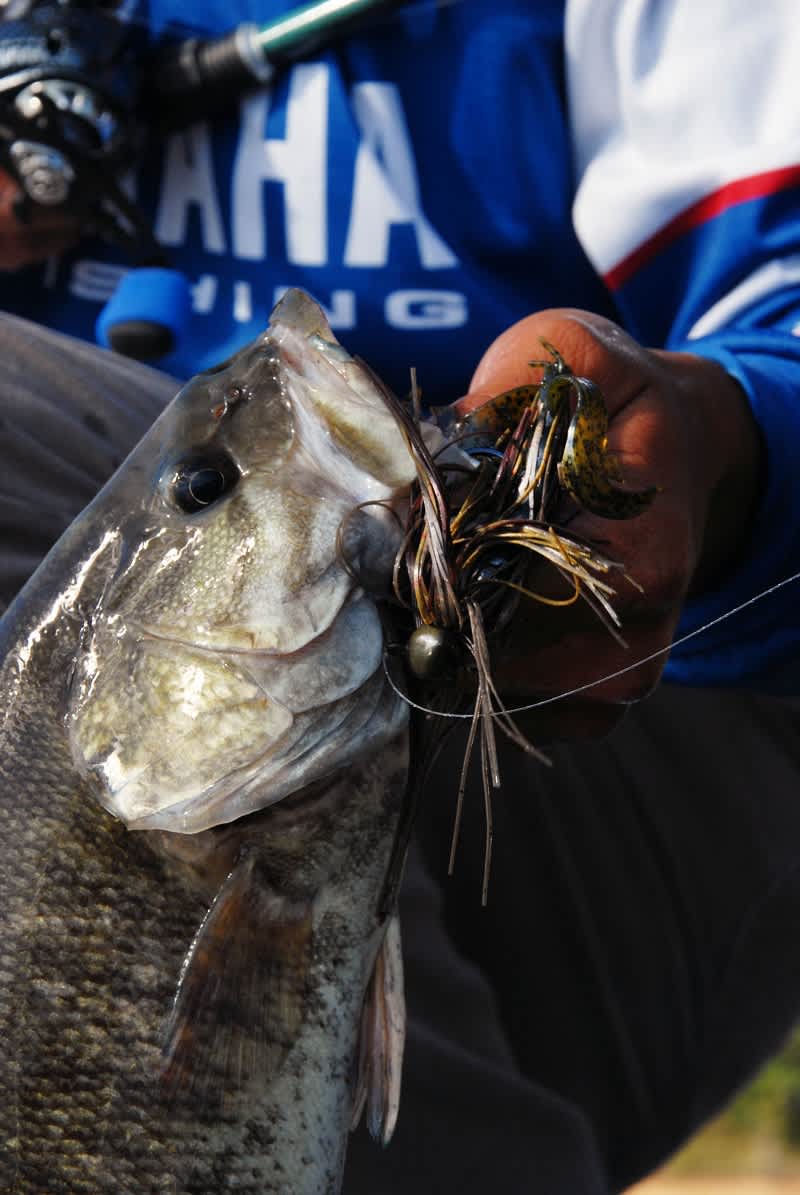Dancing the Fall and Winter Jig That Bass Like to Eat
John E. Phillips 11.04.14

Most anglers fish some form of jig all year long, especially when the weather cools down, the grass dies off, and the bass shift gears from a shallow-water feeding pattern to a deep water feeding pattern. You can catch bass on a jig this weekend on lakes and rivers throughout the nation.
Swimming a jig
As aquatic weeds die in rivers and lakes and cold fronts move in, bass will hold in the submerged grass, looking up for bait to eat. By swimming the jig just above the grass, the bass holding in the grass often will come up and take the swimming jig. Or, as you swim the jig above the grass, if the water’s clear and you can see holes in the grass, then just as the jig approaches the hole in the grass, you can drop your rod tip, let the jig fall, and get a strike. This tactic also produces good numbers of big bass when you’re swimming the jig above the grass, and you come to the edge of the grass line and allow the jig to fall. Swimming a jig also can be deadly effective when you find suspended bass along ledges, drop-offs, and points. You can swim the jig just above the suspended bass and make bass bite, or you can cast the jig out and let it free-fall through the school and possibly get a reaction bite.
Crawling a jig
Bass fishermen generally use this tactic with either a black and blue jig with the same color trailer or a green pumpkin-colored jig and trailer. You want the jig to look like a crawfish that’s moving slowly across the bottom, presenting an easy meal.
After interviewing 12 different professional bass fishermen about where they’ll start fishing a lake they’ve never fished before or don’t have any research on, they all agreed that points on the main river channel tend to be the most productive places to locate bass on any lake or river in the fall. Most of the pros say they’ll fish these points with jigs.
Bass usually congregate on points all year, and you easily can determine the water depth where the bass are holding by casting a jig to the shallow side of the point, reeling it down the points and letting it fall off the lip of the break. Points concentrate suspended bass, too.
On many of the Tennessee River chain of lakes that have rocky bottoms and points, the football head jig seems to produce better than the roundhead jig, since it can be retrieved without getting stuck between rocks. Most points also have brush piles on them that you can cast the jig out, crawl it along the bottom and let it crawl through, over, and around the base of underwater brush piles, stumps, logs, and other structure. On warming days, you can flip that same jig into visible cover with success.
Fishing a shaky head jig
In the world of jig fishing, the shaky head jig is a relative newcomer. Starting out, most anglers have fished plain lead head jigs with no trailers or skirts but rather with thin plastic worms with action. A fisherman can cast the shaky head jig out close to underwater structure or cover and let the jig sit on the bottom for a couple of seconds motionless. Then with a slack line, he can shake his rod tip to cause the worm to dance in place on the bottom. Because a bass’ metabolism slows down during cool months, the bass slowly can move up to the worm and suck it into its mouth by exerting little energy.
But in recent years, anglers have adapted other types of soft plastic lures to the shaky head jig, including creature baits like Strike King’s Wild Thing and Rodent and lizards. One of the best fall tactics is to attach a Zoom Magnum Finesse Worm to the shaky head jig. Shake the rod tip to give the bait action as it sits in place on the bottom to catch large bass on underwater roadways, drop-offs, ledges and places where bass school during the fall and winter. Too, when bass stop schooling on top and busting the surface, if you have a shaky head jig handy, you can cast it to the place where you’ve last seen the bass and possibly catch one or two more bass out of the school.
The biggest advantage of fishing the shaky head jig and worm combination or the jig and creature bait combination is that you can leave this lure in one spot and give it plenty of action. The bait stays within the strike zone of the often slow moving and reluctant to bite bass in the late fall for a longer time than almost any type of lure you can use.
To learn more about bass fishing, get John E. Phillips’ eBooks and print books by going to John’s Author Page on Amazon.

